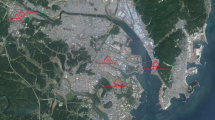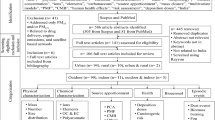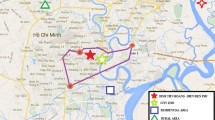Abstract
Ambient aerosols were sampled by a high-volume cascade impactor in Istanbul, through May 2012 and November 2014. Seventy-eight size-segregated samples were gathered within the period at six different stages. The particles exhibited tri-modal distribution. The peak at <0.49 μm was the most dominant among the others. The average mass median diameter was 1.3 μm. The average total suspended particulate concentration was 75 μg m−3, and PM10, PM4, PM2.5, and PM1 concentrations, derived from log-probability plots, were 62.5, 52.9, 46.9, and 34.2 μg m−3, respectively. Particle concentrations related to meteorological conditions through Pearson’s correlation coefficient. The Pearson’s correlation coefficient was poor in describing the association between coarse particles and meteorological conditions due to the increased urban effect, short-range transportation of marine aerosols, and long-range transportation. Particles >7.2 and 7.2–3 μm had a strong relation, indicating same sources. Increased relative humidity enriched 0.95–1.5-μm particle fraction in winter. Particles between 0.49 and 3 μm were inversely related to ambient temperature. Dilution effect of the wind was significant for PM1.5. Wind acted as a source for larger particles by carrying them from other source regions. Multiple linear regression was applied to particulate matter fractions in order to model the concentrations of each fraction related to meteorological data. In the model, the particle fractions of 1.5–0.95 and 0.95–0.49 μm exhibited the highest prediction performance.




Similar content being viewed by others
References
Agus EL, Young DT, Lingard JJN, Smalley RJ, Tate JE, Goodman PS, Tomlin AS (2007) Factors influencing particle number concentrations, size distributions and modal parameters at a roof-level and roadside site in Leicester, UK. Sci Total Environ 386:65–82. doi:10.1016/j.scitotenv.2007.07.026
Aiken LS, West SG, Pitts SC (2003) Multiple linear regression. Handbook of Psychology 481–507. doi:10.1002/0471264385.wei0219
Akyüz M, Çabuk H (2009) Meteorological variations of PM2.5/PM10 concentrations and particle-associated polycyclic aromatic hydrocarbons in the atmospheric environment of Zonguldak, Turkey. J Hazard Mater 170:13–21. doi:10.1016/j.jhazmat.2009.05.029
Bernstein JA et al (2004) Health effects of air pollution. J Allergy Clin Immun 114:1116–1123. doi:10.1016/j.jaci.2004.08.030
Bi X, Sheng G, Pa P, Chen Y, Fu J (2005) Size distribution of n-alkanes and polycyclic aromatic hydrocarbons (PAHs) in urban and rural atmospheres of Guangzhou, China. Atmos Environ 39:477–487. doi:10.1016/j.atmosenv.2004.09.052
Brown J, Gordon T, Price O, Asgharian B (2013) Thoracic and respirable particle definitions for human health risk assessment. Part Fibre Toxicol 10:12
Cetin B, Yatkin S, Bayram A, Odabasi M (2007) Ambient concentrations and source apportionment of PCBs and trace elements around an industrial area in Izmir, Turkey. Chemosphere 69:1267–1277. doi:10.1016/j.chemosphere.2007.05.064
Charron A, Harrison RM (2003) Primary particle formation from vehicle emissions during exhaust dilution in the roadside atmosphere. Atmos Environ 37:4109–4119. doi:10.1016/S1352-2310(03)00510-7
Cheung K, Daher N, Kam W, Shafer MM, Ning Z, Schauer JJ, Sioutas C (2011) Spatial and temporal variation of chemical composition and mass closure of ambient coarse particulate matter (PM10–2.5) in the Los Angeles area. Atmos Environ 45:2651–2662. doi:10.1016/j.atmosenv.2011.02.066
Chrysikou LP, Samara CA (2009) Seasonal variation of the size distribution of urban particulate matter and associated organic pollutants in the ambient air. Atmos Environ 43:4557–4569. doi:10.1016/j.atmosenv.2009.06.033
Dockery DW et al (1993) An association between air pollution and mortality in six U.S. cities. New Eng J Med 329:1753–1759. doi:10.1056/NEJM199312093292401
Duan Z, Han X, Bai Z, Yuan Y (2016) Fine particulate air pollution and hospitalization for pneumonia: a case-crossover study in Shijiazhuang, China. Air Qual Atmos Health 9:723–733. doi:10.1007/s11869-015-0383-y
Duarte RMBO, Mieiro CL, Penetra A, Pio CA, Duarte AC (2008) Carbonaceous materials in size-segregated atmospheric aerosols from urban and coastal-rural areas at the western European coast. Atmos Res 90:253–263. doi:10.1016/j.atmosres.2008.03.003
European PartC (2008) Directive 2008/50/EC of the European Parliament and of the Council of 21 May 2008 on Ambient Air Quality and Cleaner Air for Europe
Gonçalves C, Figueiredo BR, Alves CA, Cardoso AA, Vicente AM (2017) Size-segregated aerosol chemical composition from an agro-industrial region of São Paulo state, Brazil. Air Qual Atmos Health 10:483–496. doi:10.1007/s11869-016-0441-0
Halonen JI, Lanki T, Yli-Tuomi T, Tiittanen P, Kulmala M, Pekkanen J (2009) Particulate air pollution and acute cardiorespiratory hospital admissions and mortality among the elderly. Epidemiology 20:143–153. doi:10.1097/EDE.0b013e31818c7237
Hanedar A, Alp K, Kaynak B, Baek J, Avsar E, Odman MT (2011) Concentrations and sources of PAHs at three stations in Istanbul, Turkey. Atmos Res 99:391–399. doi:10.1016/j.atmosres.2010.11.017
Hien TT, Thanh LT, Kameda T, Takenaka N, Bandow H (2007) Distribution characteristics of polycyclic aromatic hydrocarbons with particle size in urban aerosols at the roadside in Ho Chi Minh City, Vietnam. Atmos Environ 41:1575–1586. doi:10.1016/j.atmosenv.2006.10.045
Hieu NT, Lee B-K (2010) Characteristics of particulate matter and metals in the ambient air from a residential area in the largest industrial city in Korea. Atmos Res 98:526–537. doi:10.1016/j.atmosres.2010.08.019
Hoek G, Brunekreef B, Fischer P, van Wijnen J (2001) The association between air pollution and heart failure, arrhythmia, embolism, thrombosis, and other cardiovascular causes of death in a time series study. Epidemiology 12:355–357
Infante R, Acosta IL (1991) Size distribution of trace metals in Ponce, Puerto Rico air particulate matter. Atmos Environ Part B Urban Atmos 25:121–131. doi:10.1016/0957-1272(91)90046-H
IPCC (2001) Aerosols, their direct and indirect effects. Climate Change 2001: The Scientific Basis. Contribution of Working Group I to the Third Assessment Report of the Intergovernmental Panel on Climate Change
Jerrett M et al (2005) Spatial analysis of air pollution and mortality in Los Angeles. Epidemiology 16:727–736
Karaca F, Anil I, Alagha O (2009) Long-range potential source contributions of episodic aerosol events to PM10 profile of a megacity. Atmos Environ 43:5713–5722. doi:10.1016/j.atmosenv.2009.08.005
Kaufman YJ, Tanre D, Boucher O (2002) A satellite view of aerosols in the climate system. Nature 419:215–223
Kenneth Wolfenbarger J, Seinfeld JH (1990) Inversion of aerosol size distribution data. J Aerosol Sci 21:227–247. doi:10.1016/0021-8502(90)90007-K
Künzli N et al (2000) Public-health impact of outdoor and traffic-related air pollution: a European assessment. Lancet 356:795–801. doi:10.1016/S0140-6736(00)02653-2
Kuzu SL (2016a) Compositional variation of PCBs, PAHs, and OCPs at gas phase and size segregated particle phase during dust incursion from the Saharan Desert in the northwestern Anatolian peninsula. Adv Meteorol 2016:12. doi:10.1155/2016/7153286
Kuzu SL (2016b) Source identification of combustion-related air pollution during an episode and afterwards in winter-time in Istanbul. Environ Sci Poll Res. doi:10.1007/s11356-016-7831-6
Kuzu SL, Saral A, Demir S, Summak G, Demir G (2013) A detailed investigation of ambient aerosol composition and size distribution in an urban atmosphere. Environ Sci Poll Res 20:2556–2568. doi:10.1007/s11356-012-1149-9
Kuzu SL, Saral A, Summak G, Çoltu H, Demir S (2014) Ambient polychlorinated biphenyl levels and their evaluation in a metropolitan city. Sci Total Environ 472:13–19. doi:10.1016/j.scitotenv.2013.11.031
Lin C-C, Chen S-J, Huang K-L, Lee W-J, Lin W-Y, Tsai J-H, Chaung H-C (2008) PAHs, PAH-induced carcinogenic potency, and particle-extract-induced cytotoxicity of traffic-related nano/ultrafine particles. Environ Sci Technol 42:4229–4235. doi:10.1021/es703107w
Lingard JJN, Tomlin AS, Clarke AG, Healey K, Hay AWM, Wild CP, Routledge MN (2005) A study of trace metal concentration of urban airborne particulate matter and its role in free radical activity as measured by plasmid strand break assay. Atmos Environ 39:2377–2384. doi:10.1016/j.atmosenv.2004.05.063
Lohmann U, Feichter J (2005) Global indirect aerosol effects: a review. Atmos Chem Phys 5:715–737. doi:10.5194/acp-5-715-2005
Lundgren DA, Hlaing DN, Rich TA, Marple VA (1996) PM10/PM2.5/PM1 data from a trichotomous sampler. Aerosol Sci Technol 25:353–357. doi:10.1080/02786829608965401
Maté T, Guaita R, Pichiule M, Linares C, Díaz J (2010) Short-term effect of fine particulate matter (PM2.5) on daily mortality due to diseases of the circulatory system in Madrid (Spain). Sci Total Environ 408:5750–5757. doi:10.1016/j.scitotenv.2010.07.083
Pateraki S, Asimakopoulos DN, Flocas HA, Maggos T, Vasilakos C (2012) The role of meteorology on different sized aerosol fractions (PM10, PM2.5, PM2.5–10). Sci Total Environ 419:124–135. doi:10.1016/j.scitotenv.2011.12.064
Pekney NJ, Davidson CI, Zhou L, Hopke PK (2006) Application of PSCF and CPF to PMF-modeled sources of PM2.5 in Pittsburgh. Aerosol Sci Technol 40:952–961. doi:10.1080/02786820500543324
Perrino C, Tiwari S, Catrambone M, Torre SD, Rantica E, Canepari S (2011) Chemical characterization of atmospheric PM in Delhi, India, during different periods of the year including Diwali festival. Atmos Poll Res 2:418–427. doi:10.5094/APR.2011.048
Polissar AV et al (1999) The aerosol at Barrow, Alaska: long-term trends and source locations. Atmos Environ 33:2441–2458. doi:10.1016/S1352-2310(98)00423-3
Pope IC, Burnett RT, Thun MJ et al (2002) Lung cancer, cardiopulmonary mortality, and long-term exposure to fine particulate air pollution. JAMA 287:1132–1141. doi:10.1001/jama.287.9.1132
Şahin Ü, Scherbakova K, Onat B (2012) Size distribution and seasonal variation of airborne particulate matter in five areas in Istanbul, Turkey. Environ Sci Pol Res 19:1198–1209. doi:10.1007/s11356-011-0634-x
Salma I, Ocskay R, Raes N, Maenhaut W (2005) Fine structure of mass size distributions in an urban environment. Atmos Environ 39:5363–5374. doi:10.1016/j.atmosenv.2005.05.021
Tai APK, Mickley LJ, Jacob DJ (2010) Correlations between fine particulate matter (PM2.5) and meteorological variables in the United States: implications for the sensitivity of PM2.5 to climate change. Atmos Environ 44:3976–3984. doi:10.1016/j.atmosenv.2010.06.060
Talukdar SS, Swihart MT (2003) An improved data inversion program for obtaining aerosol size distributions from scanning differential mobility analyzer data. Aerosol Sci Technol 37:145–161. doi:10.1080/02786820300952
Trippetta S, Sabia S, Caggiano R (2016) Fine aerosol particles (PM1): natural and anthropogenic contributions and health risk assessment. Air Qual Atmos Health 9:621–629. doi:10.1007/s11869-015-0373-0
Uygur N, Saral A, Yetilmezsoy K, Demir S, Kuzu SL, Celikten H, Abdul-Wahab SA (2014) Flux potentials of aerosols and their spatial variations in a coastal metropolis. Atmos Sci Lett 15:227–238
Vasilakos C, Pateraki S, Veros D, Maggos T, Michopoulos J, Saraga D, Helmis CG (2007) Temporal determination of heavy metals in PM2.5 aerosols in a suburban site of Athens, Greece. J Atmos Chem 57:1–17. doi:10.1007/s10874-006-9058-2
Wang YQ, Zhang XY, Draxler RR (2009) TrajStat: GIS-based software that uses various trajectory statistical analysis methods to identify potential sources from long-term air pollution measurement data. Environ Model Softw 24:938–939. doi:10.1016/j.envsoft.2009.01.004
Whitby KT (1978) The physical characteristics of Sulfur aerosols. In: Husar RB, Lodge JP, Moore DJ (eds) Sulfur in the atmosphere. Pergamon, New York, pp 135–159. doi:10.1016/B978-0-08-022932-4.50018-5
Yin J, Harrison RM (2008) Pragmatic mass closure study for PM1.0, PM2.5 and PM10 at roadside, urban background and rural sites. Atmos Environ 42:980–988. doi:10.1016/j.atmosenv.2007.10.005
Yorifuji T, Yamamoto E, Tsuda T, Kawakami N (2005) Health impact assessment of particulate matter in Tokyo, Japan. Arch Environ Occup Health 60:179–185. doi:10.3200/AEOH.60.4.179-185
Zanobetti A et al (2004) Ambient pollution and blood pressure in cardiac rehabilitation patients. Circulation 110:2184–2189
Acknowledgements
This research was co-funded by the research fund of TUBITAK (project number 111Y225) and Yildiz Technical University Scientific Research Projects Coordination Department (project number “2012-05-02-DOP01”)
Author information
Authors and Affiliations
Corresponding author
Rights and permissions
About this article
Cite this article
Kuzu, S.L., Saral, A. The effect of meteorological conditions on aerosol size distribution in Istanbul. Air Qual Atmos Health 10, 1029–1038 (2017). https://doi.org/10.1007/s11869-017-0491-y
Received:
Accepted:
Published:
Issue Date:
DOI: https://doi.org/10.1007/s11869-017-0491-y




